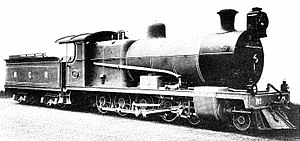NGR Hendrie B
| NGR Hendrie B SAR Class 1 (1A) |
|
|---|---|
|
NGR No. 275 / NGR Hendrie B
|
|
| Number: | 50 + 21 |
| Manufacturer: | North British |
| Year of construction (s): | 1904, 1910 |
| Type : | 2'D n2 |
| Gauge : | 1067 mm ( cape track ) |
| Length over coupling: | 17,193 (17,628) mm |
| Service mass: | 71.68 (71.78) t |
| Service mass with tender: | 105.16 (112.98) t |
| Wheel set mass : | 14.9 (14.8) t |
| Coupling wheel diameter: | 1,155 mm |
| Control type : | Walschaerts |
| Cylinder diameter: | 520.7 mm |
| Piston stroke: | 609.6 mm |
| Boiler overpressure: | 130.9 N / cm² |
| Grate area: | 3.16 m² |
The vehicles of the type Hendrie B of the Natal Government Railways (NGR) were a Tender steam locomotives with the wheel arrangement 2'd. They were named after DA Hendrie, the Chief Mechanical Engineer of the NGR and designer of the locomotives. Six examples temporarily converted to 2'D1 'locomotives were the world's first Mountain locomotives.
history
The North British Locomotive Company delivered 50 locomotives in 1904; they were given the track numbers 275 to 324. They were the first NGR locomotives with a tender , and they were superior to the tank locomotives used up to then in terms of performance and range. They were the first locomotives to make the route between Durban and Pietermaritzburg and back in one day.
In 1906 the six youngest of these locomotives were fitted with a trailing axle to improve running properties (see conversion to Mountain ).
1910 North British afforded a further 21 2'd locomotives in improved performance, as Improved Hendrie B were labeled.
When the NGR were merged with other railways to form South AfricanRailways (SAR) in 1910 , the 44 unmodified locomotives of the first delivery were classified as class 1 with the numbers 1245–1288 and the 21 locomotives of the second delivery as class 1A with the numbers 1289– 1309.
The last locomotives were taken out of service after almost 70 years of service in the early to mid-1970s. At least two locomotives (No. 1276 and 1277) have been preserved.
technology
In contrast to the 2'D classes 7 and 8 of the Cape Government Railway (CGR), the locomotives had a voluminous Belpaire boiler with a wide standing boiler above the coupling wheels. Because the boiler was arranged relatively low, the grate was almost level with the underside of the long boiler. To prevent the flames from reaching the boiler tubes directly, one wall of firebricks was placed in front of the grate, which also created a kind of combustion chamber .
In the machines delivered in 1910, the bowl was raised by 32 mm. In addition, these machines were equipped with a power reversal, which was also retrofitted to the older locomotives over time. The locomotives themselves were only about 100 kg heavier, whereby the maximum axle load was even slightly reduced, but the tender was enlarged and weighed 7.6 t (details in brackets in the table).
All locomotives were built on a plate frame and the controls corresponded to the Walschaerts / Heusinger type. The four-axle tender ran on two bogies .
Unlike many other older series, the locomotives did not have standard boilers, but kept the Belpaire boilers until the end of their service.
Conversion to mountain
In 1906 the locomotives with the numbers 319 to 324 were provided with a trailing axle in a Bissel frame to improve the running characteristics in passenger train service and thus got the 2'D1 'wheel arrangement. The increase in the guided length led to a reduction in the rolling movements at higher speeds. This is how the world's first Mountains came into being , two years before the first 2'D1 'tender locomotives were delivered to the New Zealand State Railways. The first tank locomotives with this wheel arrangement were built in 1888 - also for the NGR (type Dübs A ).
The SAR assigned these six locomotives to Class 1B and gave them the numbers 1440-1445. When the machines were no longer used in mainline passenger train service, these trailing axles were removed again between 1926 and 1928, and the locomotives were put into class 1.
The machines were the impetus for the construction of further 2'D1 'locomotives, a design that became the standard in South Africa - in no other country in the world have so many Mountain locomotives been in use. As early as 1909, the NGR procured further Mountain machines, the Hendrie D (later class 3 of the SAR) and the American D (later class 3A).
literature
- Leith Paxton, David Bourne: Locomotives of the South African Railways. A Concise Guide. C. Strui (Pty) Ltd., Cape Town 1985, ISBN 0-86977-211-2 .
Notes and individual references
- ↑ Pictures of the locomotives 1276 and 1277
- ↑ Preserved and current railways of Southern Africa (English)
- ↑ a b Wilhelm Reuter: Record Locomotives. The fastest on the rails. 1848 - 1950. 2nd edition. Motorbuch-Verlag, Stuttgart 1988, ISBN 3-87943-582-0 .

